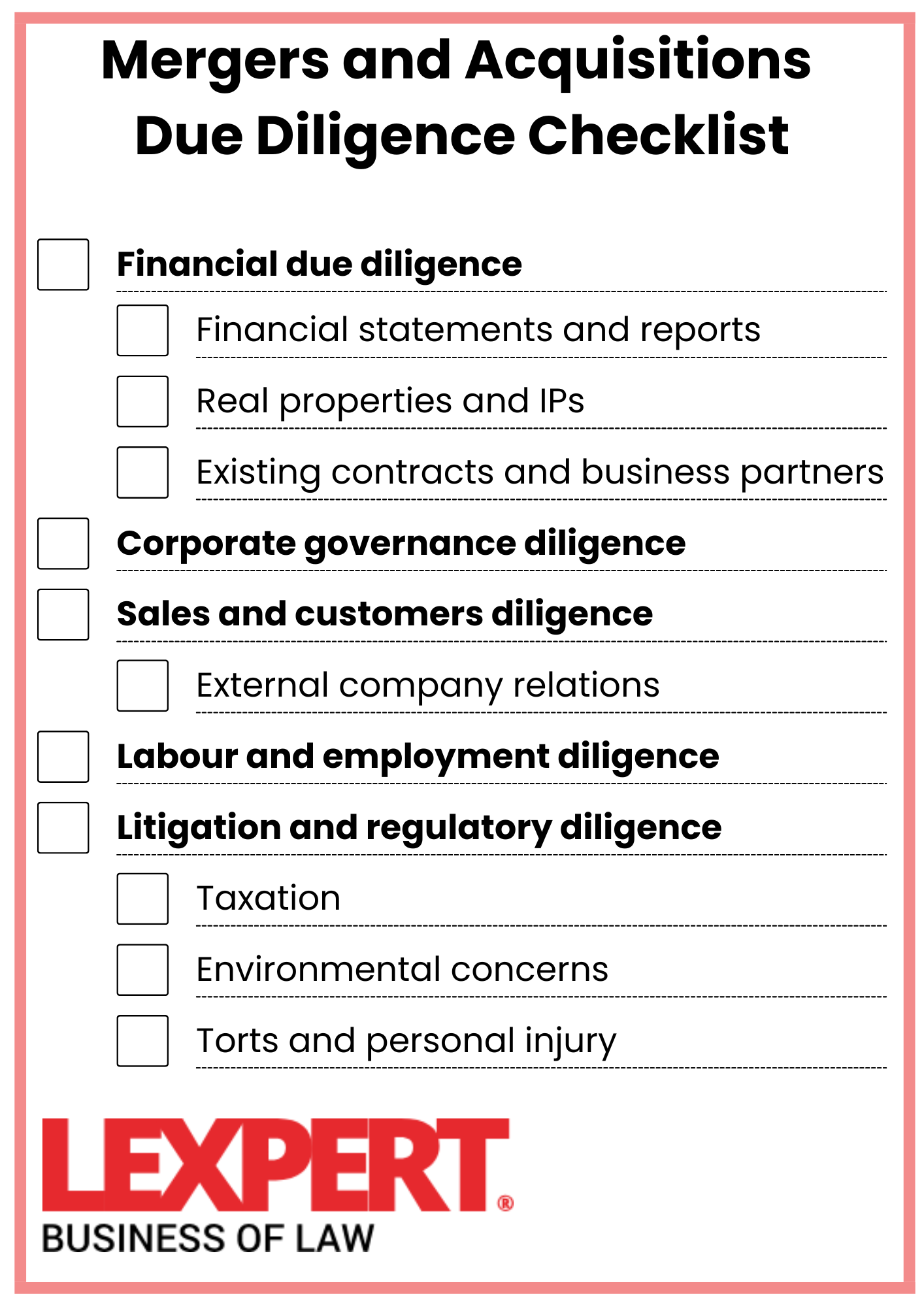When it comes to M&A deals, comprehensive preparation is the key. For this, a well-structured mergers and acquisitions due diligence checklist can help parties in the transaction ensure that nothing important slips through the cracks.
Here, we’ll discuss some of the important details that your checklist must have. If we missed something out, consulting with an M&A lawyer may also be your best option.
What is M&A due diligence?
Due diligence is that investigative process, where one company reviews the other company before a commercial transaction pushes through. As applied in mergers and acquisitions (M&As), due diligence is the thorough examination of the other company that it wants to merge with or to buy.
It’s usually done by a buying company when it reviews several target companies before a choice is made. However, due diligence in M&As may also be done by the other side — the selling company — such as before accepting the M&A proposal of the buying company.
“Due diligence is an investigative process typically undertaken by a buyer and its advisors when evaluating a target business or asset with a view to understanding and addressing risk through the review of target-specific information,” says Jeffrey Hart. He is a business lawyer at Farris LLP, which focuses on private and public M&As, among others. He adds that it may include reviewing information that is:
- publicly available from corporate registries and other governmental organizations or
- directly from the target itself
“Completion of due diligence is an iterative process — initial results often lead to more refined search requests by a buyer and its transaction advisors in the pursuit of properly understanding a target’s assets and liabilities.”
In a usual process of an M&A deal, due diligence is done at the start or before a deal is sealed. This is because once a reviewing company finds something off while conducting due diligence, it still has time to settle the issue with the other company. In the end, the decision of the parties to continue in the M&A deal is a fully informed one and is based on factual reason.
From the perspective of the acquiring company, here’s a video that explains more about due diligence in M&As:
If you want to know more about how due diligence is conducted for M&A transactions, you can consult the best M&A lawyers in Canada as ranked by Lexpert.
Importance of M&A due diligence
Hart provided some of the important reasons for conducting due diligence in M&As:
- due diligence by the target’s advisors of the target itself often uncovers assets or liabilities the target didn’t know or forgot it had
- it's an opportunity to demonstrate value to the buyer with confidence and mitigates the possibility of a post-closing indemnity claim by the buyer
- results assist a buyer in crafting target-specific representations, warranties, and indemnities
- results may lead a buyer to consider de-risking its purchase in various ways, including by adjusting the purchase price through the introduction of a holdback or escrow
“In extreme cases, it may even cause a buyer to abandon the transaction. Ultimately, due diligence gives a party confidence that it will get the deal it bargained for,” he says.
What should be included in a mergers and acquisitions due diligence checklist?
“The scope and depth of the legal, financial and operational inquiries will vary with the client and the particular transaction at hand,” says Hart. For example, a due diligence checklist may simply include requests for information relating to:
- title and ownership over its property and assets
- financial affairs
- material liabilities
- third-party vendors
- any material contracts
However, if, for example, the target is involved in the life sciences industry, a checklist may also include requests for information relating to its:
- intellectual property interests
- licensing partners
- research and development pipeline
- any clinical trials it has conducted
To help you prepare for M&A transaction and stay organized, here’s a sample mergers and acquisition due diligence checklist you can use:
 We’ll explain each of these details below. Note that this is made for both selling and buying companies; for a more customized M&A due diligence checklist, you can edit this list or reach out to an M&A lawyer near your area.
We’ll explain each of these details below. Note that this is made for both selling and buying companies; for a more customized M&A due diligence checklist, you can edit this list or reach out to an M&A lawyer near your area.
Financial Condition
An important aspect that will affect the decision of companies to pursue the M&A deal is the financial capacities of both the buying and target companies. This can be seen from the company’s audited financial statements, such as:
- income statements
- cash flow statements
- balance sheets
- financial reports given to regulatory bodies
- other publicly available financial data
These documents will give you an idea of the capital and expenses of the company, how much its debts and liabilities are, and other financial matters.
Real and Intangible Properties
Related to looking at a company’s financial condition is learning about their assets, both tangible and intangible. These include information about the company’s:
- real properties (e.g., lands and buildings they currently own)
- intellectual properties under their own name
- other personal properties (e.g., machineries and hard equipment)
Knowing about these properties and how they’re handled by the company will also be part of plotting some of the litigation risks that may arise against the newly formed company.
Existing Contracts and Business Partners
Another element of financial due diligence is looking at these two things:
- existing contracts: since these will be inherited by the new company, the buying company should investigate them as to properly position itself when making the M&A deal and to prevent breaches of these contracts
- business partners: knowing who’s who will help the buying company with its future opportunities and possible approaches when reaching out to the target company’s existing partners
Corporate Governance
The top heads reflect what happens down the line, and this is why investigating a company’s corporate governance is an aspect of M&A due diligence. On the level of the directors and shareholders, any existing issues and risks for conflicts must be identified early on. Part of a mergers and acquisitions due diligence checklist is to discover these issues and risks by looking at how corporate affairs are handled by the top management.
As a buyer, this will also give you an idea of the proper technique when initially reaching out to the target company, until negotiations start to roll out. On the other hand, a target company can decipher the true intent of the buying company, and the possible outcome of any future talks.
Sales and Customer Approach
Insights on the sales performance, marketing methods, and actual operations is part of projecting the future growth of the new company born out of the M&A deal. Below are some of the aspects to focus on:
- what are its target markets
- how effective is the company’s operating model to these markets
- what is the public’s reception to the company’s products or services
- how do competitors treat the company
External Company Relations
Performing due diligence in the sales and customer aspects includes how the other businesses perceive the company in question, aside from looking at its competitors. Questions may be asked, such as:
- Does the company have good corporate relations with its partners?
- Does the company have a good reputation among companies in its own industry?
These opinions form part of the non-financial aspect of M&A due diligence because these may affect the merged or new company in the long run.
Labour and Employment Issues
Having a look at the current and possible concerns of employees will be important later in completing the M&A deal, especially during the integration phase. Admittedly, how the M&A deal affects the employees will flow through the public’s perception of the new company. This makes concerns about labour and employment an equally important aspect of M&A due diligence as that of its financial aspect.
Litigation and Regulatory Concerns
Both future litigation risks and history of criminal and civil actions against the company must be investigated and be part of the M&A due diligence checklist.
Any brushes with regulatory bodies are also a litigation risk that must be identified early on, such as:
- previous administrative investigations
- penalties that were imposed on the company
- company methods in handling the regulatory breach
This includes regulations on the sectors of:
- taxation
- environment
- torts and personal injury
How can a lawyer help their clients in M&A due diligence?
External and in-house M&A legal counsel play a fundamental role in synthesizing complex materials into a coherent report or other deliverable, says Hart. “There is often a short period in which to complete due diligence and M&A legal counsel remain as important advisors to incorporate nuanced contractual and other safeguards into the underlying transaction agreements to address due diligence concerns.”
As some information becomes clear and certain risks become quantifiable through the process, new uncertainties may arise. For this, he says that “M&A legal counsel are foundational to framing what follow-up questions and when to ask in order to mitigate risk.”
If you want a mergers and acquisitions due diligence checklist tailored specifically for your transaction, you can reach out to the Lexpert-ranked best law firms in Canada for M&As.





